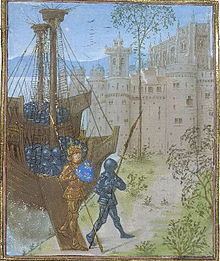6,000 knights and soldiers60 ships 40,000 men End date October 1390 | 274 Unknown Result Crusader withdrawal | |
 | ||
Similar Crusades, Crusade of 1197, Alexandrian Crusade, Smyrniote crusades, Venetian Crusade | ||
The Barbary Crusade, also called the Mahdia Crusade, was a Franco-Genoese military expedition in 1390 that led to the siege of Mahdia, then a pirate stronghold in Tunisia. Froissart's Chronicles is the chief account of what was one of the last crusades.
Contents
Background
During the lulls of the Hundred Years War knights looked for opportunities for glory and honor. As Genoese ambassadors approached the French king Charles VI to subscribe to a crusade, they eagerly supported the plan to fight Muslim pirates from North Africa. These pirates had their main base at Mahdia on the Barbary coast. Genoa was ready to supply ships, supplies, 12,000 archers and 8,000 foot soldiers, if France would provide the knights. The proposal by the doge Antoniotto Adorno was presented as a crusade. As such it would give prestige to its participants, a moratorium on their debts, immunity from lawsuits, and papal indulgence. The French force also included some English participants and consisted of 1,500 knights under the leadership of Louis II, Duke of Bourbon.
The siege of Mahdia
It has been estimated that the total force numbered about 5,000 knights and soldiers plus 1,000 sailors. Two priests representing both popes blessed the departing. An armada of about 60 ships left Genoa on July 1, 1390 and landed at the end of July near the town of Mahdi where the soldiers disembarked unchallenged. The crusaders put up their camp and invested the fortified city for the next two months. They had failed to bring sufficient siege engines to breach the walls. A relief army reportedly 40,000 men strong was brought up by Hafsid Sultan Abu al-Abbas Ahmad II supported by the kings of Bugia and Tlemesan, camped nearby, avoided pitched battle, but started to harass the crusaders. The crusaders had to build a wall around their camp and fortify it. The Berbers send out a negotiating party asking why the French would attack them, they had only troubled the Genoese, a natural affair among neighbors. In answer they were told that they were unbelievers who had "crucified and put to death the son of God called Jesus Christ." The Berbers laughed saying it was the Jews not they who had done that. Negotiations broke off.
In a subsequent encounter with the large relief army the crusaders killed many but eventually had to retreat exhausted and tired. The duration of the siege not only frustrated them, but their logistical systems started to weaken. When a final assault on the city was repelled they were ready to settle for a treaty. On the opposing side the Berbers realized that they could not overcome the heavier armed invaders. Both sides looked for a way to end the hostilities.
Lifting the siege
The siege was lifted with the conclusion of a treaty negotiated through the Genoese party. The treaty stipulated a ten-year armistice, an agreement by Mahdia of payment of taxes to Genoa for 15 years, and to Louis II for his expenses. Thus piracy from the Barbary coast was reduced, and the crusaders withdrew. By mid-October the crusaders had returned to Genoa. Losses due to fighting and disease amounted to 274 knights and squires, about 20%.
Afterwards
Both sides celebrated victory afterwards. The Berbers had repelled the invaders, and the Genoese could conduct trade with less interference. The French knights had no tangible goals but had participated for action and glory. They failed to learn any lessons from a "chivalric adventure with religious overlay" Their mistakes of unfamiliarity with the environment, lack of heavy siege equipment, underestimation of the enemy, and internal quarrels were repeated six years later on a grander scale in their fatal last crusade at Nicopolis
